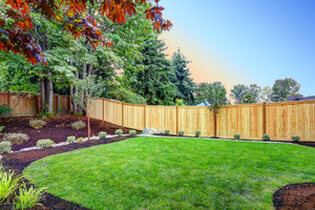Post and rail: this is a low type of fencing where you’d typically find as an enclosure for livestock and other animals. It creates a clear barrier between barriers, but doesn’t provide much in terms of privacy.
Now, there are a few types of wood used by our wood fence installers. The most popular are:
Pine: usually pressure-treated to reduce its porosity and chances of infestation and rot. A softer wood and the more affordable option among the available wood types available for fence installations. Average lifespan is 15 years. Requires annual maintenance involving cleaning and inspection for repairs and touch up sealing.
Cedar: the significantly more expensive option, this one weathers well and ages beautifully. It is a harder wood than pine and contains natural oils that naturally repel pests. Resists shrinkage and warpage. Average lifespan is 30 years.
Regardless of the type of wood used, the posts are usually made from pressure-treated pine as it is able to withstand the surrounding soil than other types of hardwood. Regular maintenance is key to preserving the fence’s longevity, and includes cleaning, inspection, applying a weatherproof and UV solution to maintain their colour and integrity.
An alternative to solid wood fencing material is wood composite which includes a combination of sawdust and shredded plastic pieces. Wood composite is used for the boards, but the posts and rails are usually still solid wood. Wood composite is quite durable and is not as susceptible to infestation as solid wood fencing (particularly pine) would be. Another alternative you can discuss with our fence experts is vinyl.
No matter what style or wood options you decide on, or if you’re still unsure, contact our Newmarket fence contractors for an assessment and estimate. We will guide you along the process, from calling Ontario One Call for locates (since it involves digging into the ground) to assisting you in selecting the style and finish that best suits your home to the final fence installation process. Aside from the material you'll use for the enclosure, you may have to decide on the type as well. What do we mean by that? Well, if our wooden fence installers were to build fencing in the front yard, you'd find most homeowners may prefer a lower height and a decent amount of spacing between the boards. If our wood fence builders were to put it up in the side or backyard, then most homeowners are likely to opt for a privacy fence in which the slats have little to no spacing in between. So these are some things to take into consideration when deciding on the function, but this is making your head swim, don't fret, as our wood fence pros will draw from our extensive experience and expertise to guide you through the process.
We're a growing fence and deck company and we've made friends all over the world, including Oxford property maintenance contractors. For a local wood fence installation in Newmarket, give us a call from a free quote.
Now, there are a few types of wood used by our wood fence installers. The most popular are:
Pine: usually pressure-treated to reduce its porosity and chances of infestation and rot. A softer wood and the more affordable option among the available wood types available for fence installations. Average lifespan is 15 years. Requires annual maintenance involving cleaning and inspection for repairs and touch up sealing.
Cedar: the significantly more expensive option, this one weathers well and ages beautifully. It is a harder wood than pine and contains natural oils that naturally repel pests. Resists shrinkage and warpage. Average lifespan is 30 years.
Regardless of the type of wood used, the posts are usually made from pressure-treated pine as it is able to withstand the surrounding soil than other types of hardwood. Regular maintenance is key to preserving the fence’s longevity, and includes cleaning, inspection, applying a weatherproof and UV solution to maintain their colour and integrity.
An alternative to solid wood fencing material is wood composite which includes a combination of sawdust and shredded plastic pieces. Wood composite is used for the boards, but the posts and rails are usually still solid wood. Wood composite is quite durable and is not as susceptible to infestation as solid wood fencing (particularly pine) would be. Another alternative you can discuss with our fence experts is vinyl.
No matter what style or wood options you decide on, or if you’re still unsure, contact our Newmarket fence contractors for an assessment and estimate. We will guide you along the process, from calling Ontario One Call for locates (since it involves digging into the ground) to assisting you in selecting the style and finish that best suits your home to the final fence installation process. Aside from the material you'll use for the enclosure, you may have to decide on the type as well. What do we mean by that? Well, if our wooden fence installers were to build fencing in the front yard, you'd find most homeowners may prefer a lower height and a decent amount of spacing between the boards. If our wood fence builders were to put it up in the side or backyard, then most homeowners are likely to opt for a privacy fence in which the slats have little to no spacing in between. So these are some things to take into consideration when deciding on the function, but this is making your head swim, don't fret, as our wood fence pros will draw from our extensive experience and expertise to guide you through the process.
We're a growing fence and deck company and we've made friends all over the world, including Oxford property maintenance contractors. For a local wood fence installation in Newmarket, give us a call from a free quote.
|
Copyright © 2020 Newmarket Fence | All rights reserved
|



